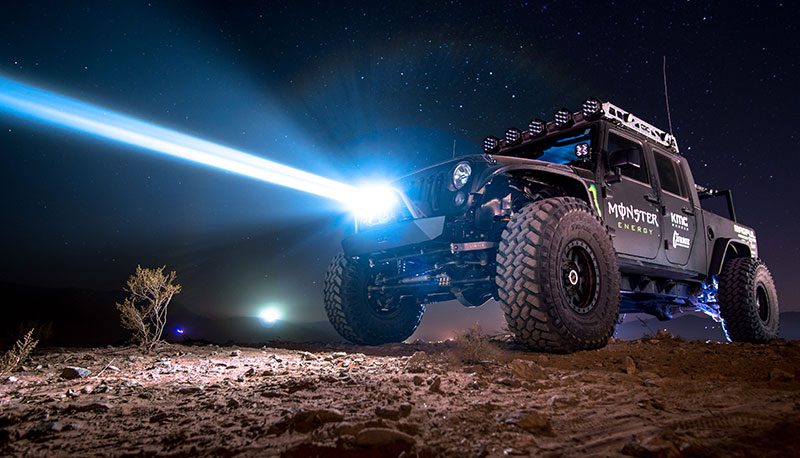When venturing into the wilderness or navigating challenging terrains at night, your vehicle’s standard headlights can only take you so far. That’s where LED off-road lights shine—literally. Designed to offer exceptional brightness, improved range, and unmatched durability, these lights have become an essential upgrade for adventurers, overlanders, and 4×4 enthusiasts worldwide.
In this article, we’ll explore how LED lighting systems elevate off-road driving, the various types available, ideal mounting options, and how to choose the best setup for your next rugged adventure.
Why LED Off-Road Lighting is a Game Changer
Unlike traditional halogen or HID bulbs, LED (Light Emitting Diode) lighting technology is more efficient, longer-lasting, and produces significantly more usable light. For off-road applications, this means better trail visibility, energy savings, and resistance to harsh environmental conditions like mud, dust, water, and impact.
LED off-road lights also come in various beam patterns and housing styles, allowing off-roaders to customize their lighting systems based on terrain type, driving speed, and personal preference.
If you’re looking to equip your vehicle with rugged, high-performance Off Road Lights that withstand extreme conditions, this collection provides reliable options for every off-roading scenario.
Top Benefits of LED Off-Road Lights
1. Superior Brightness and Clarity
LED lights generate intense white light, closely resembling daylight. This natural color temperature improves contrast, making it easier to spot rocks, potholes, animals, and trail edges during nighttime driving.
2. Energy Efficiency
Compared to halogen lights, LEDs draw less power while delivering more brightness. This ensures your vehicle’s electrical system isn’t overloaded, especially when running multiple accessories on the trail.
3. Long Lifespan
High-quality LED lights can last up to 50,000 hours or more. Their solid-state construction means fewer moving parts, reducing the risk of failure on rough terrains.
4. Rugged Durability
LED off-road lights are built to survive vibrations, water exposure, dust infiltration, and temperature extremes. Look for IP67 or IP68 rated lights for maximum reliability.
Types of LED Off-Road Lights
Depending on your lighting needs, LED off-road lights come in a variety of configurations. Here’s a breakdown of popular options:
LED Light Bars
LED light bars are mounted horizontally on the roof or bumper and offer massive lighting coverage. They’re available in single or dual-row formats, and often combine both spot and flood beams in one unit for versatile use.
Spot Beam LEDs
Spot beam LED lights project a narrow, focused beam ideal for long-distance visibility. These are perfect for fast-paced desert driving or when you’re scouting trails far ahead.
Flood Beam LEDs
Floodlights spread a wide beam that illuminates your immediate surroundings. They’re ideal for rock crawling, forest trails, and other slow, technical driving situations.
Combo Beam Lights
Combo lights integrate spot and flood patterns in one unit, giving you both reach and width. They’re one of the most popular choices for all-purpose off-road driving.
Rock Lights
These small LED lights mount beneath your vehicle and illuminate the ground underneath. They help drivers see obstacles under the chassis and are particularly useful for night crawling.
Best Mounting Locations for LED Lights
Mounting location greatly affects beam spread, visibility, and overall lighting performance. Choose a location based on your off-road goals and terrain:
- Roof Rack or Windshield Mount: Great for wide-range visibility over long distances
- Front Bumper or Grille: Provides focused frontal illumination while maintaining a low profile
- A-Pillar or Hood Cowl: Enhances peripheral visibility and ditch lighting
- Underbody or Wheel Wells: For undercarriage lighting and rock-crawling visibility
Always use stainless steel mounting brackets, water-tight wiring, and switches designed for automotive use.
How to Choose the Right LED Off-Road Lighting System
With so many choices, it’s important to find a lighting setup that fits your vehicle, driving environment, and budget. Consider these factors:
- Terrain Type: Sand dunes need more long-distance lighting, while forests benefit from wide-angle beams.
- Vehicle Size: Larger vehicles can support bigger bars and more light fixtures.
- Light Output: Measured in lumens, output should match your trail’s complexity and driving speed.
- Water and Dust Resistance: Go for lights with high IP ratings to survive extreme conditions.
- Color Temperature: Lights between 5000K to 6000K mimic daylight and provide better trail contrast.
FAQs About LED Off-Road Lights
Q1: Can LED off-road lights be used on the highway?
A: Most LED off-road lights are not road-legal unless approved or used with covers. Always check local laws and avoid blinding oncoming traffic.
Q2: Are LED lights better than halogen or HID for off-road use?
A: Yes, LEDs are more durable, energy-efficient, and provide brighter, whiter light, making them ideal for rugged terrains and nighttime driving.
Q3: How many lumens are good for off-roading?
A: For general off-roading, 3,000 to 6,000 lumens is sufficient. More technical or high-speed trails may require 10,000+ lumens across multiple lights.
Q4: What beam pattern should I choose?
A: For all-around use, combo beam lights are best. Use spot beams for high-speed open terrain and flood beams for tight, technical trails.
Q5: Do LED off-road lights drain the car battery quickly?
A: No, LEDs consume less power compared to halogen or HID lights. However, leaving them on for extended periods with the engine off can still deplete your battery.
Final Thoughts
Whether you’re exploring rugged mountain trails, crawling over rocks at night, or navigating foggy backroads, LED off-road lights can significantly enhance your driving experience. Their unmatched brightness, low power draw, and superior durability make them a must-have upgrade for anyone serious about off-roading.

